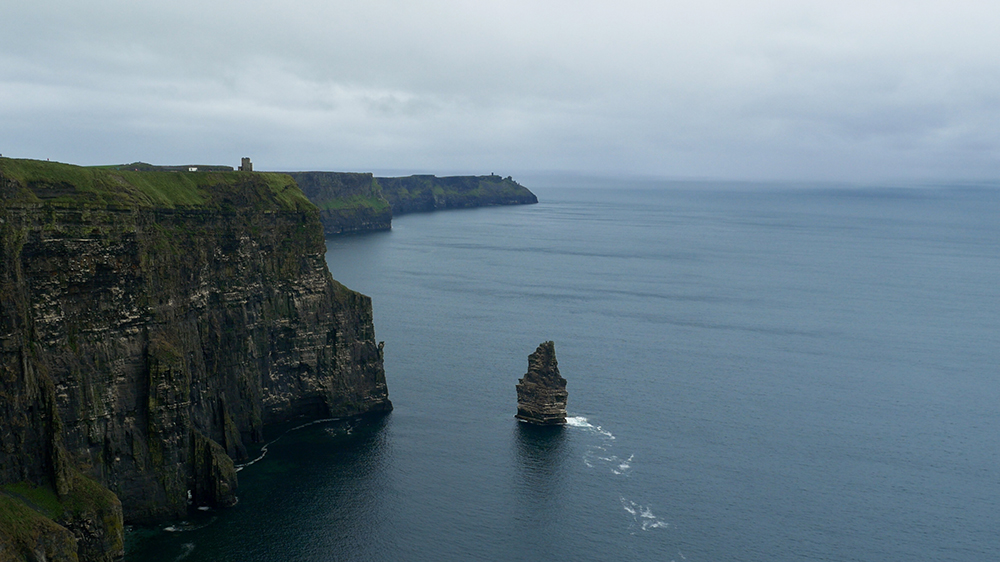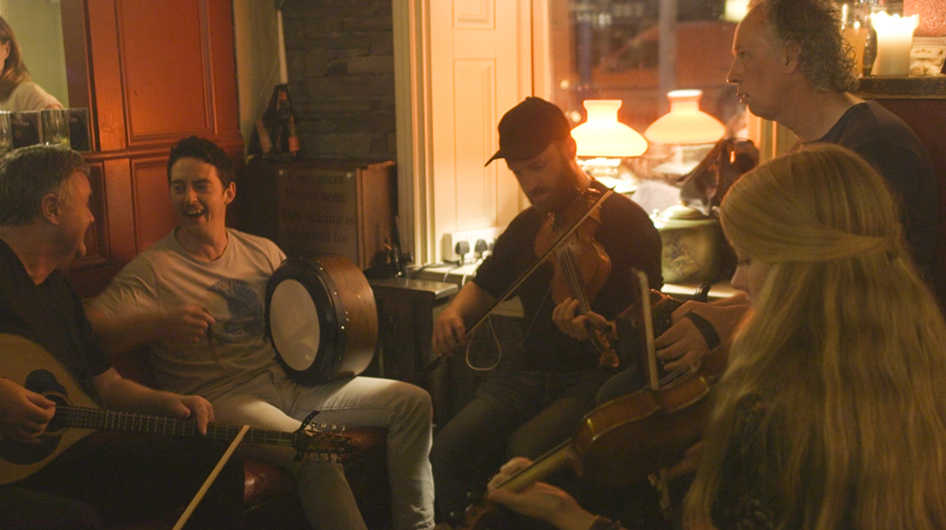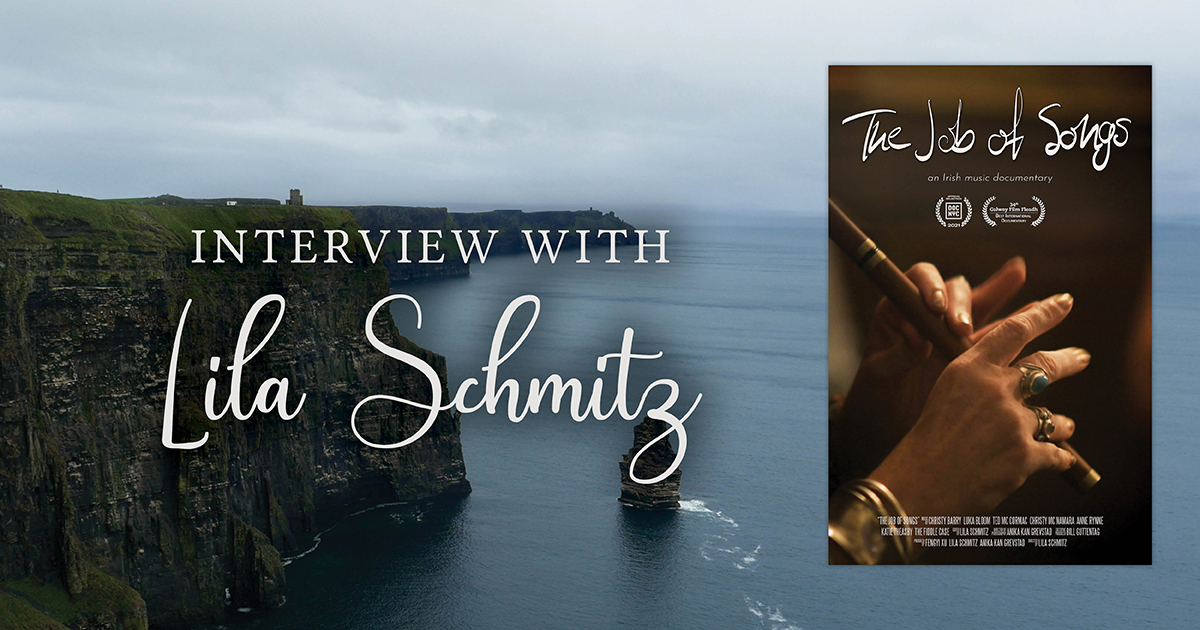Lila Schmitz is a talented filmmaker and director behind the Irish music documentary The Job of Songs. The story centers around the musicians in Doolin in County Clare, Ireland. It’s a beautiful and layered look at this small community of musicians, their traditions, and the humanity that infuses them. We chatted with Lila over the phone to find out more about the documentary and the journey to the story.
The Interview
[Editor’s note: This interview has been lightly edited for clarity.]
Ayla Ruby: The documentary talks about people all over finding their way to Doolin. I’m curious about you and how you found your way to Doolin. and the story.
Lila Schmitz: Yeah. Well, when I was a teenager, I traveled to Ireland with my family, and we have ancestors that go way back on that old island. So we were visiting some relatives and then we were just traveling around and we went to Doolin, which is in County Clare on the west coast of Ireland. And I was just really blown away by the sessions and it’s set against this beautiful, the Cliffs of Moher, which are sort of this institution almost that the land has created and people come to see from all over the world. The music just fully drew me in.
On why the idea for this documentary stuck with her
Ayla Ruby: Now, what was the journey to making this and developing this? So you have this interest and ancestry, you visited there. How did you know this was the story that you were going to turn from this kernel into this larger documentary?

Location: Cliffs of Moher, County Clare, Ireland
Photo Credit: Anika Kan Grevstad
Lila Schmitz: Yeah, absolutely. I was graduating from college, and there was a documentary grant that came about, and I was sort of like, okay, you can’t pass up the opportunity to make something. And when I was thinking about what could I enjoy making and what could feel really true to trying to capture something special? And the only thing that I kept thinking about was that session. It had been years and years since I had been, but it just stuck with me so strongly. And there was this feeling within the session; I think I had thought back to it throughout the years and just been really taken with the feeling of it. And so the film is and was an attempt to capture the feeling of a session.
Ayla Ruby: Was this the, and I apologize if I pronounce this wrong, the Brendan Fahy Bequette [Filmmaking] Series?
Lila Schmitz: Oh, the grant. Oh, the grant was just through our college. It’s called the CC Documentary Exploration Grant through Colorado College. It was the first year that it happened.
Ayla Ruby: Oh, gotcha.
Lila Schmitz: Yeah. Yeah.
On creating a community of filmmakers
Ayla Ruby: Okay. So what about you have some amazing partners on this film. You have Bill Guttentag; you have other folks; you have your cinematographer [Anika Kan Grevstad]. Can you talk about how they came onto the project how you built those relationships?
Lila Schmitz: So Anika Kan Grevstad, who shot the film and is a producer on it, and Fengyi Xu, who’s a producer, and the three of us really were the people who carried this throughout. They have done so much on the film, as have I, just inhabiting all these different roles. And we all went to college together; we got the grant together. They were the people who, when I was like, okay, I’m going to try to go capture this feeling, who do I think would be the most on top of it and willing and creative. And I had made projects with them and just had a wonderful time. And we still, the three of us, collaborate a lot, and I make almost everything that I make with Anika. Fengyi is not in the US anymore, but I would make things with her if she was.
On how Doug Pray and Bill Guttentag joined the project
Lila Schmitz: And then Doug Pray is a mentor. He was my college professor on documentary, so it’s all very tied to the school, but he taught me documentary and then became a mentor as a part of the grant project. And through that, just was really helpful in showing us what was possible and answering our many, many questions and giving us notes and all of that as we went through.
Lila Schmitz: And then Bill Guttentag was my boss and I was an assistant. We worked on a number of different projects. We worked on That Animal Rescue Show, which was a Richard Linklater-led docuseries based out of Austin, which is where I’m from. So I got involved with that, and that’s how I met Bill. And then, we went on to work on various other projects. I co-produced a documentary feature with him called Spiral and just continued to work with him for quite a while. So learned a bunch from him, and he was intrigued by the film. He really liked where it was headed and got involved that way.
Lila Schmitz what draws her to documentary versus scripted films
Ayla Ruby: So you’ve mentioned a couple of other projects as well, and I’m curious what really draws you to documentary as a medium, just as a filmmaker, as opposed to something that’s scripted? Can you talk about what appeals to you about that?
Lila Schmitz: Yeah, I feel like I have an on-and-off relationship with documentary because I love it so dearly, but it is such a challenge. I think that there’s something about “doc” for me that I just have to come to terms with loving it because the truth behind what people are saying, and I’m not someone who believes in being able to objectively tell the truth through storytelling. I think that there’s always going to be a viewpoint of the filmmaker in there.

Lila Schmitz: I’m of course, shaping the way that the story is told, but there is such a beauty in having words from the people who are describing it specifically with music. I think that there’s, just in trying to describe this feeling for this film in particular, that is something that A) these musicians had not really tried to do. When I was asking them questions, they had been interviewed tons of times; they’re pretty established musicians.
Lila Schmitz: They’ve dealt with stuff like this, and they were like, “Oh, these are new questions for us.” And so I think I love that part of it. It’s like a puzzle in a conversation.
Lila Schmitz: Every person that I sat down with it was a chat at a kitchen table, having a cup of tea. They gave us pie. We have this whole saga of people feeding us because we had so little time that we forgot to eat.
Ayla Ruby: Oh no.
Lila Schmitz: And so they would make us sandwiches and pie and tea and coffee if I was lucky. And it was just this very intimate relationship that you have with the person who you can just ask them these questions.
It’s something really unique to documentary in that even with my family, I’m not sitting down and asking them their deepest, darkest feelings all the time. So I think I love that part of it. I love being able to open up myself and help other people open up. I think that in writing a documentary, it’s so fascinating to piece together this script that you already have, but you have to figure out how to make it engaging and communicate what it was that drew me into these conversations try to share that with an audience.
On her approach to the musicians of Doolin in County Clare
Ayla Ruby: It sounds like from what you’re saying, everyone was very welcoming, and even though these folks are very established musicians, I think there was someone with a thirty-year career..quite these amazing careers. Can you talk about how you approached them? How did you connect with them? What was your premise? Because, again, it’s such an interesting documentary.
Lila Schmitz: Thanks. Yeah, I mean, the Irish are notoriously not very open. They’re very open to chatting about the surface-level things. But actually, getting to these feelings and such was not something that I necessarily expected and was not something that they expected from sitting down to have a conversation with me. And so, in order to gain the trust, when Anika and I first got there, Fengyi didn’t come until two weeks later. Anika and I were just sort of walking around town. We did not have a car, which in Ireland doesn’t work out, it turns out.
Ayla Ruby: Yes.
Lila Schmitz: But we were walking around with our cameras. We would go into sessions and not necessarily shoot anything but just be there with our cameras, which were very small, and just trying to meet people in person and make people comfortable. And so we did not go in knowing who we were going to be filming with. It was very off-the-cuff, very much following the story as it came to us.
On how patience and pub conversations turned to story
Lila Schmitz:And we would sit down to have an interview with someone we met in the pub, and they would say, “Oh, you have to talk to so-and-so.” And so I think that patience that we had with it helped a lot and I think helped the musicians feel like we were not there to necessarily be exploitative or just come in and leave, which is a very common thing that they face there, with tourism being such a quick industry and people making assumptions about a place having been there for a few hours and all of that.
Lila Schmitz: So I think that helped a lot. And just also, my personal curiosity about it and coming from a place of this is something that has touched me, and I’m curious why. That is something that they were very willing to talk about because, obviously, the session music has touched them as well and is something that we connected on. And I didn’t come in with preconceived notions necessarily, or I wasn’t telling them what to do, which surprisingly does happen in documentary a lot.

Location: The Roadside Tavern in Lisdoonvarna, County Clare, Ireland
Subject: Katie Theasby
Photo Credit: Anika Kan Grevstad
Ayla Ruby: Oh wow.
Lila Schmitz: I think that helped. Yeah.
On the biggest challenges in bringing The Job of Songs to screen
Ayla Ruby: It’s interesting that you mention establishing this relationship with folks because I think there was even a moment in the film where they talked about people don’t wait anymore, and that being one of the things that’s kind of missing as time progresses. So it’s kind of interesting how that the parallels to that. I guess I’m curious: were there any really big challenges in bringing this to life?
Lila Schmitz: Oh yeah, lots of them. Let’s see. I mean, here’s the thing. This was a project that Anika, Fengyi, and I went into with the intention of making a short film as a post-grad project. Fengyi was still in college, just sort of, oh, we should keep making stuff and do that. And we got there, and it was such a rich culture, and people were so open like we talked about and really willing to chat. So we came away with this breadth of information and knowledge and feeling and all of this footage. It was firstly something we were transitioning from a short film to a feature. None of us had made a feature film before, so I’m still learning things. It’s been five and a half years.
Ayla Ruby: It’s a whole different beast.
Lila Schmitz: Yeah. And I think one thing to the point of having worked with Bill and other folks, and Anika worked with Doug Pray, our mentor post-grad, the three of us were doing full-time jobs where we were learning things that then were brought back to this process. And so we would step away for months at a time and come back and bring that knowledge, which I think helped a lot.
Lila Schmitz: But I think the main challenge was just not knowing what we were doing and not really having an infrastructure behind what we were doing. But I also think that that gave us a lot of freedom. So I’m hesitant to paint that all bad because I think there’s something in being like, well, we’re going to make what we’re going to make, and it’s going to be what we want it to be. And we didn’t have the restrictions around creating something that a lot of people do because it was so homegrown.
Lila Schmitz on the message of The Job of Songs
Ayla Ruby: Okay. So, there was one section of the film where the musicians talk about the message of a song. And I’m curious, is there an overall message of this documentary that you want people to take away with them after they’re done viewing it?
Lila Schmitz: I think that everyone will have their own takeaway and experience, and that’s been something really beautiful about hearing from audiences. But for me, this film serves as a reminder of the types of communities that humans are capable of creating. And it reminds me of the fact that people are coming together to support each other and, to connect with each other, and to experience joy and life in space together. And I think that has been something that, for me, has been a big takeaway, and I go back to watch it, and I’m reminded of that because it’s very easy to forget.
Ayla Ruby: I understand. I think that’s a great note to end on, too. I really thank you for your time, and this is, just again, a wonderful story.
Lila Schmitz: Thank you so much. I really appreciate it.
How to watch The Job of Songs
The Job of Songs is now available to preorder in the US & Canada, and available to stream in Ireland and the UK. Find out more by visiting the documentary’s official website. You can learn more about Lila Schmitz by visiting her website.
You can check out the trailer for the documentary below:
Are you interested in watching The Job of Songs? Join the conversation below, or follow us on X (formerly Twitter) @MoviesWeTexted to continue the discussion.
Are you interested in more in-depth interviews with filmmakers? Check out our other interviews, including our recent chat with writer and director Matthew Yerby from The Dirty South.

